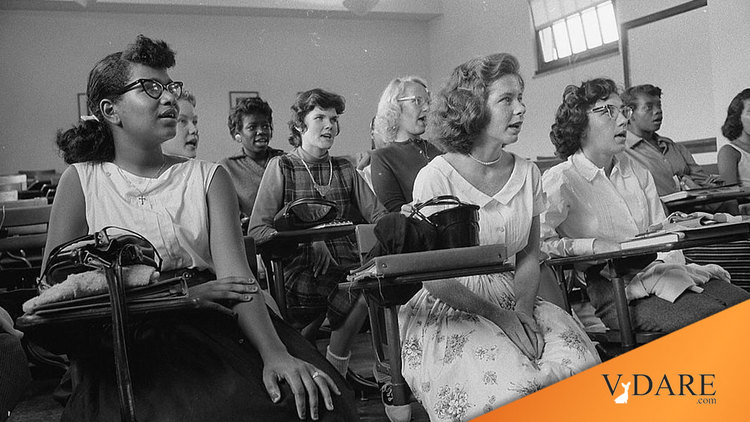
The Michigan Mess: Supreme Court’s Lawlessness Dates Back To Brown
06/30/2003
Columnists have had a field day with Justice Sandra Day O'Connor’s Supreme Court decision [Grutter PDF]. In effect, O'Connor declared diversity to be a "compelling state interest" that trumps the equal protection clause of the U.S. Constitution.
Thomas Sowell described the five-member majority as "vacancies without resignations." Shelby Steele declared the ruling "a victory for white guilt." Michael Kinsley wrote that O'Connor was splitting "a difference that cannot be split."
The most striking feature of the decision is the absence of legal argument. The ruling rests on sociological babble about "critical mass diversity."
The substitution of sociology for law is the legacy of the 1954 Brown desegregation decision.
Devoid of any legal argument, the Brown decision rested on sociological testimony about whether black children preferred white to black dolls and on Swedish socialist Gunnar Myrdal’s assertion that white Americans are "aversive racists." This meant, Myrdal asserted, that democracy would perpetuate segregation as long as whites comprised a political majority.
To end segregation, the Supreme Court would have to usurp the legislative function.
That is precisely what the Court did in 1954. Although liberals cheered the end of "separate but equal," constitutional lawyers were disturbed by the absence of legal reasoning in the Court’s ruling. For example, Columbia Law Professor Herbert Wechsler, a consultant to the NAACP in the Brown case, told the Harvard Law School that he was unable to find the constitutional principal that justified the decision. He recommended that the Brown decision be accepted on faith.
Even today Americans do not realize that the Brown decision strikes at the heart of democracy by substituting judicial coercion for persuasion and good will. The ruling made coercion the essence of civil rights. To protect themselves from lawsuits, private companies and public universities established racial quotas for "preferred minorities."
Today Americans find themselves in the peculiar situation that racial quotas have been ruled unconstitutional by the Supreme Court (Bakke 1978, Gratz 2003 PDF), but businesses and universities can nevertheless be sued if they don’t have them.
The U.S. Department of Justice considers all employers without proportional representation of racial minorities (or a quota system to achieve it) to be ipso facto guilty of racial discrimination. To settle civil rights lawsuits, companies are required to pay monetary damages and to institute a quota system to remedy the alleged discrimination.
Both Brown and Grutter are declared to be "landmark decisions." Yet both are devoid of legal basis. After a half century of a civil rights cause driven by the principle that the ends justify the means, we have a legal system that is based in sociological rant.
A legal system unmoored from law can go in any direction. As the dissenting minority put it, the O'Connor opinion subverts the Court’s "own controlling precedents." A Supreme Court without precedents can deliver any kind of ruling, depending on how the wind blows or on what the Court can get away with.
The O'Connor decision institutionalizes a lie. It says that quotas are permissible as long as they are disguised and can be denied to exist. The way to achieve this disguise is by eschewing point systems that reward skin color (Gratz), and instead choose preferred minorities individually. The quota sneaks in under the cover of "critical mass diversity."
As "critical mass" happens to be the same as proportional representation, the scheme operates as a racial quota for blacks.
Racial profiling, which is not permitted in crime prevention or airport security, is just dandy at institutions of higher learning.
The liberal majority on the Court is trying to favor minorities without having to declare the end of equal protection for whites. The "O'Connor compromise" denies that admission based on diversity is racial privilege.
O'Connor speculates that after another quarter century "affirmative action" will no longer be necessary and somehow will disappear, a speculation that demonstrates a mind vacant of any legal understanding of the doctrine of adverse possession (squatters' rights).
We have had racial quotas for 35 years. In 25 more years, racial quotas, acknowledged or not, will be a 60-year tradition. Racial privilege will be so ingrained that only a civil rights revolution would be able to reestablish equality before the law.
The evaded question is: Why does a ruling that is not based in legal or constitutional analysis mean anything — especially when the entire legal ability of the sitting Court resides in the four dissenters?
We would have obtained just as good a ruling if we had asked a drug addict.
Any fool could have delivered the O'Connor decision.
That is what makes it a landmark.
Paul Craig Roberts is the author of The New Color Line: How Quotas And Privilege Destroy Democracy, with Lawrence M. Stratton.
COPYRIGHT CREATORS SYNDICATE, INC.
